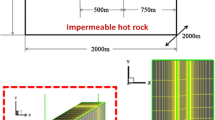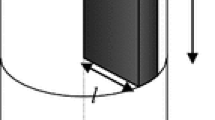Abstract
Enhanced oil recovery (EOR) techniques have garnered the attention of the oil industry because they promise to extend the life of hydrocarbon reservoirs that have passed their peak of productivity. The heat and momentum transfer equations are the main governing equations for the thermal EOR processes. Thermal EOR, in particular, helps improve the extraction yield by injecting heat into the reservoir and altering the physical properties of porous rocks (e.g., permeability) and fluids therein (e.g., viscosity). Simulation modelling can help improve our understanding of the underlying thermal processes, but its prediction accuracy largely depends on the use of the correct energy balance equation as the governing equation. This study considered two established energy balance equations: the first without porosity (case I); and the second with porosity in terms of thermal energy transported by heat conduction (case II). We numerically solved the model equations and compare the porosity anomalies in both cases. Our results show that the inclusion of porosity in the heat conduction term of the energy balance equation has a significant impact on the temperature profile of the reservoir and dimensionless numbers in heat transfer because it increases the fluid storage capacity of the porous medium. Therefore, one should carefully select the appropriate energy balance equation for the defined porous medium. It is also established that Hossain–Abu-Khamsin numbers \(N_{HA3} \) and \(N_{HA4} \) become important when porosity is considered. Porosity plays a significant role in temperature distribution. In addition, the study showed that the thermal conductivity of fluids has more influence on the temperature profile than that of solid rocks. The findings have important implications for improving the yield and efficiency of thermal EOR.
Similar content being viewed by others
Abbreviations
- A :
-
Cross sectional area of rock perpendicular to the flow of flowing fluid (m\(^{2}\))
- \(c_\mathrm{f} \) :
-
Total fluid compressibility of the system (1/Pa)
- \(c_\mathrm{s} \) :
-
Formation rock compressibility of the system (1/Pa)
- \(c_\mathrm{t} \) :
-
Total compressibility of the system (1/Pa)
- \(c_\mathrm{pf} \) :
-
Total specific heat capacity of the formation fluids (kJ/kg K)
- \(c_\mathrm{pg} \) :
-
Specific heat capacity of gas (kJ/kg K)
- \(c_\mathrm{po} \) :
-
Specific heat capacity of oil (kJ/kg K)
- \(c_\mathrm{ps} \) :
-
Specific heat capacity of solid rock matrix (kJ/kg K)
- \(c_\mathrm{pw} \) :
-
Specific heat capacity of water (kJ/kg K)
- \(h_\mathrm{c} \) :
-
Convection heat transfer coefficient (kJ/h m\(^{2}\) K)
- k :
-
Reservoir permeability (m\(^{2}\))
- \(k_\mathrm{e} \) :
-
Overall effective thermal conductivity of fluid saturated porous media (kJ/h m K)
- \(k_\mathrm{eff} \) :
-
Local effective thermal conductivity of fluid saturated porous media (kJ/h m K)
- \(k_\mathrm{f} \) :
-
Absolute thermal conductivity of fluid within the porous rock matrix (kJ/h m K)
- \(k_\mathrm{g} \) :
-
Thermal conductivity of gas (kJ/h m K)
- \(k_\mathrm{o} \) :
-
Thermal conductivity of oil (kJ/h m K)
- \(k_\mathrm{s} \) :
-
Absolute thermal conductivity of solid rock matrix (kJ/h m K)
- \(k_\mathrm{w} \) :
-
Thermal conductivity of water (kJ/h m K)
- L :
-
Distance between production and injection well along x direction (m)
- \(L_\mathrm{c} \) :
-
Characteristic length related to pore-throat diameter (m)
- \(L^{*}\) :
-
Dimensionless length of the reservoir
- M :
-
Average system heat capacity (kJ/m\(^{3}\) K)
- \(N_\mathrm{PeL}\) :
-
\(L_\mathrm{c} \rho _\mathrm{f} c_\mathrm{pf} u_x /k_\mathrm{e}=\) local Peclet number (dimensionless)
- p :
-
Pressure of the system (Pa)
- \(p_\mathrm{i} \) :
-
Initial pressure of the system (Pa)
- \(p_0 \) :
-
A reference pressure of the system (Pa)
- \(q_\mathrm{i} \) :
-
Au = initial volume production rate (m\(^{3}\)/s)
- \(q_x \) :
-
Fluid mass flow rate per unit area in x-direction (kg/m\(^{2}\) s)
- \(q^{*}\) :
-
Dimensionless volume production rate
- \(q_\mathrm{inj} \) :
-
Injection volume flow rate of steam = Au (m\(^{3}\)/s)
- \(q_\mathrm{prod} \) :
-
Production volume flow rate of oil = Au (m\(^{3}\)/s)
- \(r_\mathrm{pt} \) :
-
Pore-throat radius (microns)
- \(S_\mathrm{g} \) :
-
Gas saturation (volume fraction)
- \(S_\mathrm{o} \) :
-
Oil saturation (volume fraction)
- \(S_\mathrm{w} \) :
-
Water saturation (volume fraction)
- \(S_\mathrm{wi} \) :
-
Initial water saturation (volume fraction)
- t :
-
Time (s)
- T :
-
Temperature (K)
- \(T_\mathrm{f} \) :
-
Temperature of injected fluid (K)
- \(T_\mathrm{s} \) :
-
Average temperature of solid rock matrix (K)
- \(T^{*}\) :
-
Dimensionless temperature
- \(T_\mathrm{HW} \) :
-
Temperature of injected fluid (K)
- \(T_\mathrm{HW}^*\) :
-
Dimensionless temperature of injected fluid
- \(T_\mathrm{i} \) :
-
Initial reservoir temperature (K)
- \(t^{*}\) :
-
Dimensionless time
- \(u_x \) :
-
Fluid velocity in porous media in the direction of x axis (m/s)
- \(u^{*}\) :
-
Dimensionless velocity
- x :
-
Flow dimension at any point along x-direction (m)
- \(x^{*}\) :
-
Dimensionless distance
- \(\alpha \) :
-
Fractional order of differentiation, dimensionless
- \(\alpha _\mathrm{H}\) :
-
\(k/\phi \mu c_\mathrm{t} =\) hydraulic diffusivity of the fluid-saturated porous medium (m\(^{2}\)/s)
- \(\Delta T\) :
-
Temperature difference (K)
- \(\upsilon \) :
-
\(\mu /\rho _\mathrm{f} =\) kinematic viscosity (ratio of absolute or dynamic viscosity to density) (m\(^{2}\)/s)
- \(\mu \) :
-
Fluid dynamic viscosity (Pa s)
- \(\rho \) :
-
Fluid density (kg/m\(^{3}\))
- \(\Delta \rho \) :
-
\(\rho _\mathrm{w} -\rho _\mathrm{o} =\) density difference of fluids (water and oil) (kg/m\(^{3}\))
- \(\phi \) :
-
Porosity of the rock matrix, volume fraction
- \(\rho _\mathrm{f} \) :
-
Weighted-average density of the formation fluids (kg/m\(^{3}\))
- \(\rho _\mathrm{g} \) :
-
Density of gas (kg/m\(^{3}\))
- \(\rho _\mathrm{o} \) :
-
Density of oil (kg/m\(^{3}\))
- \(\rho _\mathrm{s} \) :
-
Density of solid rock matrix (kg/m\(^{3}\))
- \(\rho _\mathrm{w} \) :
-
Density of water (kg/m\(^{3}\))
- API:
-
American petroleum institute
- rb:
-
Reservoir barrels
- stb:
-
Standard barrels
- scf:
-
Standard cubic feet
References
Iaffaldano, G.; Caputo, M.; Martino, S.: Experimental and theoretical memory diffusion of water in sand. Hydrol. Earth Syst. Sci. 10(1), 93–100 (2006)
Hossain, M.E.; Mousavizadegan, S.H.; Islam, M.R.: The effects of thermal alterations on formation permeability and porosity. Pet. Sci. Technol. 26(10–11), 1282–1302 (2008a)
Hossain, M.E.; Mousavizadegan, S.H.; Islam, M.R.: Rock and fluid temperature changes during thermal operations in EOR processes. J. Nat. Sci. Sustain. Technol. 2(3), 347–378 (2008b)
Hossain, M.E.; Mousavizadegan, S.H.; Islam, M.R.: Effects of memory on the complex rock-fluid properties of a reservoir stress-strain model. Pet. Sci. Technol. 27(10), 1109–1123 (2009a)
Hossain, M.E.; Mousavizadegan, S.H.; Islam, M.R.: Variation of rock and fluid temperature during thermal operations in porous media. Pet. Sci. Technol. 27, 597–611 (2009b)
Cloot, A.; Botha, J.F.: A generalized groundwater flow equation using the concept of non-integer order derivatives. Water SA 32(1), 1–7 (2006)
Di Giuseppe, E.; Moroni, M.; Caputo, M.: Flux in porous media with memory: models and experiments. Transp. Porous Media 83(3), 479–500 (2010)
Spillette, A.G.: Heat transfer during hot fluid injection into an oil reservoir. J. Can. Pet. Technol. 4, 213–218 (1965)
van Poollen, H.K.; Associates Inc.: Fundamentals of Enhanced Oil Recovery, vol. 74101, pp. 155. PennWell Publishing Company, Tulsa (1980)
Chan, Y.T.; Banerjee, S.: Analysis of transient three-dimensional natural convection in porous media. J. Heat Transf. 103, 242–248 (1981)
Lake, L.W.: Enhanced Oil Recovery. Prentice Hall, Englewood Cliffs (1989). 07632
Satman, A.; Zolotukhin, A.B.; Soliman, M.Y.: Application of the time-dependent overall heat-transfer coefficient concept to heat-transfer problems in porous media. Soc. Pet. Eng. J. 24, 107–112 (1984)
Kaviany, M.: Principles of Heat Transfer. Wiley, New York (2002)
Dawkrajai, P.; Lake, L.W.; Yoshioka, K.; Zhu, D.; Hill, A.D.: Detection of water or gas entries in horizontal wells from temperature profiles. In: SPE—100050, Presented at SPE/DOE Symposium on Improved Oil Recovery, Tulsa, Oklahoma, 22–26 Apr (2006)
Yoshioka, K.; Zhu., D.; Hill, A.D.; Dawkrajai, P.: Lake, L.W.: Detection of water or gas entries in horizontal wells from temperature profiles. In: SPE—100209, Presented at SPE Europe/EAGE Annual Conference and Exhibition, Vienna, Austria, 12–15 June (2006)
Yoshioka, K.; Zhu, D.; Hill, A.D.; Dawkrajai, P.; Lake, L.W.: Prediction of temperature changes caused by water or gas entry into a horizontal well. In: SPE–100209, SPE Production & Operations, pp. 425–433, Nov (2007)
Yoshioka, K.; Zhu, D.; Hill, A.D.; Lake, L.W.: A new inversion method to interpret flow profiles from distributed temperature and pressure measurements in horizontal wells. In: SPE—109749, SPE Production & Operations, pp. 510–521, Nov (2009)
Weibo, S.; Ehlig-Economides, C.; Zhu, D.; Hill, A.D.: Determining multilayer formation properties from transient temperature and pressure measurements in commingled gas wells. In: SPE 131150, Presented at the CPS/SPE International Oil & Gas Conference and Exhibition, Beijing, 8–10 June (2010)
Cengel, Y.A.; Ghajar, A.J.: Heat and Mass Transfer: Fundamentals and Applications, 4th edn. McGraw-Hill, New York (2011)
Wang, Z.; Horne, R.N.: Analyzing wellbore temperature distributions using nonisothermal multiphase flow simulation. In: SPE 144577, Presented at the SPE Western North American Regional Meeting, Anchorage, Alaska, 7–11 May (2011)
Hossain, M.E.; Abu-Khamsin, S.A.: Utilization of memory concept to develop heat transfer dimensionless numbers for porous media undergoing thermal flooding with equal rock-fluid temperatures. J. Porous Media 15(10), 937–953 (2012a)
Hossain, M.E.; Abu-Khamsin, S.A.: Development of dimensionless numbers for heat transfer in porous media using memory concept. J. Porous Media 15(10), 957–973 (2012b)
Hossain, M.E.; Mousavizadegan, S.H.; Islam, M.R.: Rock and fluid temperature changes during thermal operations in EOR processes. J. Nat. Sci. Sustain. Technol. 2(3), 347–378 (2008)
Marx, J.W.; Langenheim, R.H.: Reservoir heating by hot fluid injection. Trans. Soc. Pet. Eng. AIME 216, 312–315 (1959)
Simacek, P.; Advani, S.G.: An analytic solution for the temperature distribution in flow through porous media in narrow gaps: I—linear injection. Heat Mass Transf. 38, 25–33 (2001)
Hossain, M.E.; Abu-Khamsin, S.A.; Al-Helali, A.: A mathematical model for the steam flood with equal rock and fluid temperatures. J. Porous Media 18(7), 731–744 (2015)
Kaviany, M.: Principles of Heat Transfer in Porous Media, 2nd edn. Springer, Berlin (1995)
Lee, D.Y.; Vafai, K.: Analytical characterization and conceptual assessment of solid and fluid temperature differentials in porous media. Int. J. Heat Mass Trans. 42, 423–435 (1999)
Alazmi, B.; Vafai, K.: Analysis of variants within the porous media transport models. J. Heat Transf. 122, 303–326 (2000)
Nield, D.A.; Bejan, A.: Convection in Porous Media, 3rd edn. Springer, New York (2006)
Hossain, M.E.: Scaling of heat transfer dimensionless numbers developed by memory concept for porous media application. In: Submitted to ASME Journal of Energy Resources Technology, Manuscript Number: JERT-15-1041, 30 Jan 2015, under review (2015)
Nield, D.A.; Bejan, A.: Convection in Porous Media, 2nd edn. Springer, New York (1999)
Vafai, K.: Handbook of Porous Media, pp. 1–52. Marcel Dekker, Inc., New York (2000)
Pop, I.; Ingham, D.B.: Convective Heat Transfer: Mathematical and Computational Modelling of Viscous Fluids and Porous Media. Pergamon Press, Oxford (2001)
Ingham, D.B.; Pop, I.: Transport Phenomena in Porous Media, vol. 2. Pergamon Press, Oxford (2002)
Vafai, K.: Handbook of Porous Media, 2nd edn. Taylor & Francis, Boca Raton (2005)
Tong, F.; Jing, L.; Zimmerman, R.W.: An effective thermal conductivity model of geological porous media for coupled thermo-hydro-mechanical systems with multiphase flow. Int. J. Rock Mech. Min. Sci. 46, 1358–1369 (2009)
Kolodzie, S. Jr.: Analysis of pore throat size and use of the Waxman–Smits equation to determine OOIP in spindle field. In: Colorado Society of Petroleum Engineers, 55th Annual Fall Technical Conference Paper 9382, 10p (1980)
Pittman, E.D.: Relationship of porosity and permeability to various parameters derived from mercury injection–capillary pressure curve for sandstone. AAPG Bull. 76, 191–198 (1992)
Author information
Authors and Affiliations
Corresponding author
Rights and permissions
About this article
Cite this article
Hossain, M.E. Role of Porosity on Energy Transport with Equal Rock-Fluid Temperatures During Thermal EOR Process. Arab J Sci Eng 42, 1621–1631 (2017). https://doi.org/10.1007/s13369-016-2343-8
Received:
Accepted:
Published:
Issue Date:
DOI: https://doi.org/10.1007/s13369-016-2343-8




